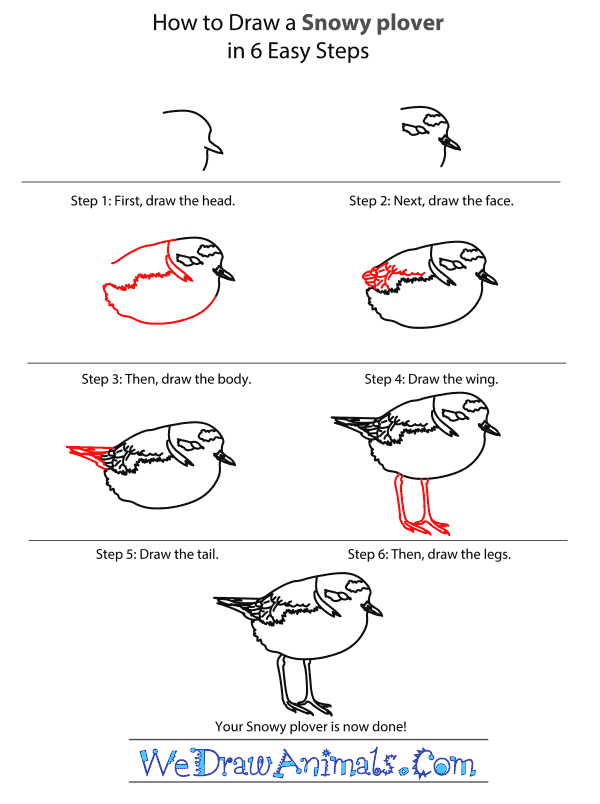In this quick tutorial you'll learn how to draw a Snowy Plover in 6 easy steps - great for kids and novice artists.
The images above represent how your finished drawing is going to look and the steps involved.
Below are the individual steps - you can click on each one for a High Resolution printable PDF version.
At the bottom you can read some interesting facts about the Snowy Plover.
Make sure you also check out any of the hundreds of drawing tutorials grouped by category.
How to Draw a Snowy Plover - Step-by-Step Tutorial
Step 1: Draw the head first. It is a slightly curved line for the top of the head, a short triangle for the beak, and another line going down for the neck.
Step 2: Next, make the facial details. Give your bird an eye. Make a line across and through the middle of the beak. Add some lines to show the facial markings.
Step 3: Now, draw the body. It is an oval shape with one end open for the wing. Draw a line from the back of the bird's head halfway across the body. Draw a line from where that ends to the tail, but make the line with tiny zigzags.
Step 4: Close the wing. Add feather details.
Step 5: Add a triangle at the back for the bird's tail. Make some feather details here too.
Step 6: Lastly, draw the legs. They are long and skinny lines. That's it, your snowy plover is done! If you'd like to color it, the back is tan, the belly is white, and the markings on its face and neck are black.
Interesting Facts about the Snowy Plover
Long thought to be a subspecies of the Kentish plover, the Snowy Plover is a small wader that lives along the Southern and Western US, Caribbean, Ecuador, Peru, and Chile. The Snowy Plover has a grey/brown tops, white bellies, and dark patches on either side of their necks. They nest along the shores of peninsulas, bays, estuaries, and rivers on the east cost of the United States.
Did you know?
- Snowy Plovers will use almost anything to make their nests including driftwood, kelp, rocks, even human footprints.
- Snowy Plovers usually lay three eggs that look like sand and can be almost impossible to see even to trained observers.
- A kite flying over a Snowy Plover nest looks like a predator and can force them to abandon their nests.
- Human activity disturbs the Snowy Plover during their mating and breeding season.
- Humans have introduced new predators and increased the populations of others for the Snowy Plover.
Lesson plan note: Conservationists have started the “Share the Shore” program to protect the Snowy Plover. Have students write down ways they think people can learn to enjoy the beach without disturbing Snowy Plover nesting sites.







